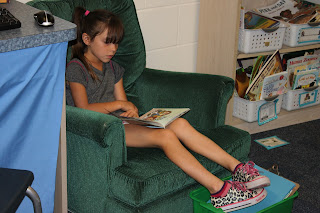We are using metacognition as we read! We are thinking about our thinking!
"Real reading" salad lesson from Comprehension Connections: Bridges to Strategic Reading by Tanny McGregor
Sunday, September 22, 2013
Wednesday, September 4, 2013
Comprehension in Action
Below you will see the students applying new information learned. They are working together to identify and describe characters, setting and events using illustrations.
Check out these first graders hard at work...
Read to Self
We are already going strong! We are improving our ability to read independently for longer periods of time every day. We are building our stamina!
Below you will see the students practicing "Read to Self". Independent reading is crucial part of our reading workshop/center time in our classrooms. Throughout the training process for "read to self" the students learn how to choose "good-fit" books using the "I-PICK" (Purpose, Interest, Comprehend, Know all the words) strategy. The students are learning that we have different purposes for reading. Sometimes we read to learn and sometimes we read for fun. To keep them motivated we also want the students to choose books based on their interests. This is the I in "I-PICK". Next, is the C for Comprehend. They students are learning to check for understanding as they read. You may have heard them talking about metacognition or thinking about thinking. The students are learning to pay attention to their thoughts as they read. Only then are they truly involved in "real" reading. The K in "I-PICK" means the students should know all (or most) of the words in a book. The students are using their 5-finger rule to help them choose their "good-fit" books. If they miss more then 5 words on a page the book is too difficult for independent reading.
Next, the students help determine the rules for "read to self". For example: no talking, spread out from friends and neighbors, keep our eyes on our books, reading the whole time, etc.

Once we have successfully chosen some good fit books and determined the expectations we begin to practice "Read to Self". To build our stamina we start small (with a 3 minute timing) and try to add at least a minute a day. Mrs. Cooper's class reached 8 minutes this week and Mrs. Coleman's class reached 10 minutes!

The purpose of "read to self" and building stamina is to help the students be successful, motivated learners. It also improves their ability to focus on independent tasks for longer periods of time. This will benefit the children in years to come as the content and skills learned become more and more difficult and require more and more of their attention.
Below you will see the students practicing "Read to Self". Independent reading is crucial part of our reading workshop/center time in our classrooms. Throughout the training process for "read to self" the students learn how to choose "good-fit" books using the "I-PICK" (Purpose, Interest, Comprehend, Know all the words) strategy. The students are learning that we have different purposes for reading. Sometimes we read to learn and sometimes we read for fun. To keep them motivated we also want the students to choose books based on their interests. This is the I in "I-PICK". Next, is the C for Comprehend. They students are learning to check for understanding as they read. You may have heard them talking about metacognition or thinking about thinking. The students are learning to pay attention to their thoughts as they read. Only then are they truly involved in "real" reading. The K in "I-PICK" means the students should know all (or most) of the words in a book. The students are using their 5-finger rule to help them choose their "good-fit" books. If they miss more then 5 words on a page the book is too difficult for independent reading.
Next, the students help determine the rules for "read to self". For example: no talking, spread out from friends and neighbors, keep our eyes on our books, reading the whole time, etc.

Once we have successfully chosen some good fit books and determined the expectations we begin to practice "Read to Self". To build our stamina we start small (with a 3 minute timing) and try to add at least a minute a day. Mrs. Cooper's class reached 8 minutes this week and Mrs. Coleman's class reached 10 minutes!

The purpose of "read to self" and building stamina is to help the students be successful, motivated learners. It also improves their ability to focus on independent tasks for longer periods of time. This will benefit the children in years to come as the content and skills learned become more and more difficult and require more and more of their attention.
Building a Classroom Community
Check out Mrs. Cooper's class collage of self portraits
Subscribe to:
Posts (Atom)
































